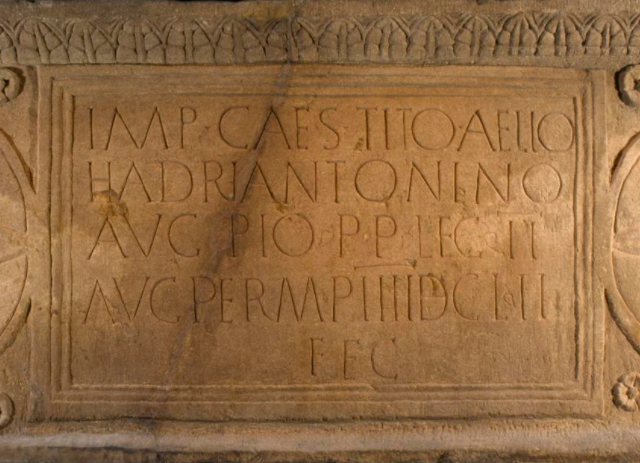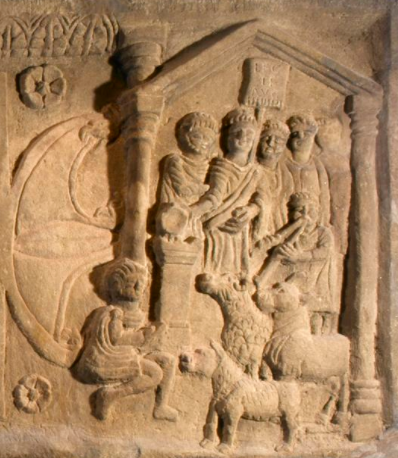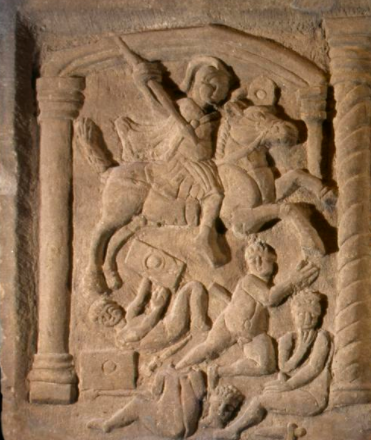Key in a search term below to search our website.
Key in a search term below to search our website.

Date
around AD 142
Found
1868
Made from
sandstone
Museum reference
X.FV 27
On display
Early People, Level 0, Roman Invaders, S004
Did you know?
Originally the slab looked even more spectacular – scientific analysis has shown that the lettering and parts of the design were picked out in paint.

The Roman stone from Bridgeness (in modern Bo’ness, on the Firth of Forth) is one of the finest pieces of Roman sculpture from Britain. It commemorated the construction of the eastern end of the Antonine Wall, the frontier built by the Romans across the narrowest part of Scotland between the Forth and Clyde estuaries, when they conquered southern Scotland in the 140s AD. A whole series of such slabs were erected along the Wall, with the most impressive one reserved for the eastern end at Bridgeness. They may have been built into the turf body of the Wall itself, or placed in separate structures nearby. Learn more about the Antonine Wall with our Romans in Scotland pages.
The stone is a spectacular monument, with a central inscribed panel flanked by sculptural scenes within architectural frames defined by columns. Each part of it carried different messages for the viewer.
The inscribed panel with its beautifully-carved letters is flanked by two curved decorative motifs that end in the heads of mythical beasts called griffins. The inscription names the emperor, Antoninus Pius, with his full official titles and honours taking up almost three lines of the text.
The remainder commemorated the legion who built this part of the wall, the Second Legion Augusta, and records exactly how much they built, down to the last pace – 4,652 of them. A Roman pace was a double-step, five Roman feet in length, so this represents 7,722m of hard work – the Antonine Wall consisted of a massive ditch, up to 12m wide and 3.6m deep, in front of a substantial wall of turf, earth and timber, erected on a stone base.


The right-hand panel shows a religious ceremony that would have taken place before the Wall was built, and before the army marched into Scotland. Three animals – a pig, a ram and a bull – were sacrificed to the war-god Mars, to purify and prepare the army for the task of conquest and construction. The animals are shown at the front of the scene, accompanied by two attendants, one playing pan-pipes.
Behind stands a group of soldiers. The one in front is probably the commander of the legion, and he pours an offering from a circular pan onto an altar. One of the soldiers behind him holds a flag to remind the viewer again that LEG II AVG built this part of the wall. The “AVG” in the title commemorates the legion’s service for Augustus, the first emperor of Rome.
Learn more about the beliefs and daily lives of people living in Roman Scotland here.
The left-hand picture glorifies the warfare and bloodshed involved in the conquest. A Roman officer on horseback is riding down four local warriors. The Roman is armed to the teeth, with helmet, body armour, shield, sword and spear.
In contrast, the locals are shown as naked, defended only by rectangular shields; their weapons (a spear and swords) have been cast aside. This is very much a piece of propaganda intended to emphasise the difference between the ‘civilised’ Romans and their ‘savage’ opponents.
The scene compresses different events: the slaughter on the battlefield, with one local being ridden down, another dying with a javelin in his back; and the aftermath of the battle, with one captive beheaded and another contemplating his fate. This triumphal image is a brutal and bloody reflection of frontier warfare, seen through the eyes of the victorious Romans.
Learn more about the Roman army in Scotland here.

The Bridgeness distance slab is in remarkably good condition. Most of these distance slabs were removed from the Wall and deliberately buried when the Romans abandoned southern Scotland, only some 20 years after the invasion.
But where did the Antonine Wall end? This slab is usually taken as evidence that it finished near Bridgeness, on a promontory sticking into the Firth of Forth. But there’s no evidence of the Wall in this area, and some archaeologists believe it finished a few hundred metres further east, at Carriden, where a Roman fort and settlement are known. Was the slab moved at some point? Or was it originally set into a monument in a dramatic and visible location near the shore? Only further excavations will confirm the history of this spectacular sculpture.